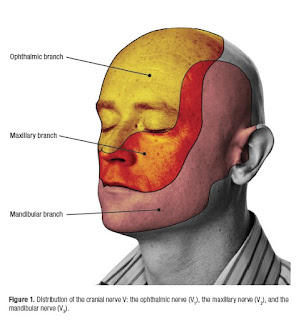Possible Nursing Diagnosis for Trigeminal Neuralgia
Trigeminal Neuralgia
Neuralgia is a stabbing pain that arises occasionally, but short and heavy, which occurs along the distribution of a nerve. Trigeminal neuralgia (NT) is neuralgia on the trigeminal nerve (fifth cranial nerve) that is responsible for sensation in the face. Trigeminal neuralgia (facial pain) is characterized by brief episodes of strong facial pain, stabbing, and like electricity.
According to Dr. Dito Anurogo, Trigeminal Neuralgia is a complaint of pain attacks one side of the face are repeated. Called trigeminal neuralgia, because facial pain occurs in one or more nerves than the three branches of Trigeminal nerve. This large nerve located in the brain and carries sensation from the face to the brain. The pain is caused by a disturbance in Trigeminal nerve function in accordance with the regional distribution of innervation of one branch of the trigeminal nerve caused by a variety of causes.
Etilogy trigeminal neuralgia is still not fully understood. There is one theory that because the blood vessels, especially the superior cerebral artery, into decompression, so that chronic irritation of the trigeminal nerve into the root section. This irritation causes increased afferent controls blame, or sensory nerves. Risk factors that can trigger is multiple sclerosis and hypertension. Other factors that may cause neuralgia including herpes virus infections, infections of the teeth and jaws, and brain stem infarction. (Miller, 2009 in Lewis 2011).
Nursing Diagnosis that may appear on the client with Trigeminal Neuralgia according Muttaqin, Arif (2010) and Ackley, Betty J., Gail B. Ladwig (2013) is as follows.
Neuralgia is a stabbing pain that arises occasionally, but short and heavy, which occurs along the distribution of a nerve. Trigeminal neuralgia (NT) is neuralgia on the trigeminal nerve (fifth cranial nerve) that is responsible for sensation in the face. Trigeminal neuralgia (facial pain) is characterized by brief episodes of strong facial pain, stabbing, and like electricity.
According to Dr. Dito Anurogo, Trigeminal Neuralgia is a complaint of pain attacks one side of the face are repeated. Called trigeminal neuralgia, because facial pain occurs in one or more nerves than the three branches of Trigeminal nerve. This large nerve located in the brain and carries sensation from the face to the brain. The pain is caused by a disturbance in Trigeminal nerve function in accordance with the regional distribution of innervation of one branch of the trigeminal nerve caused by a variety of causes.
Etilogy trigeminal neuralgia is still not fully understood. There is one theory that because the blood vessels, especially the superior cerebral artery, into decompression, so that chronic irritation of the trigeminal nerve into the root section. This irritation causes increased afferent controls blame, or sensory nerves. Risk factors that can trigger is multiple sclerosis and hypertension. Other factors that may cause neuralgia including herpes virus infections, infections of the teeth and jaws, and brain stem infarction. (Miller, 2009 in Lewis 2011).
Nursing Diagnosis that may appear on the client with Trigeminal Neuralgia according Muttaqin, Arif (2010) and Ackley, Betty J., Gail B. Ladwig (2013) is as follows.
- Pain (acute / chronic) r / t trigeminal nerve compression and inflammation of the temporal artery.
- Imbalanced Nutrition : Less than Body Requirements r / t pain during chewing.
- Ineffective individual coping r / t severe pain, excessive threat to the self-alone.
- Knowledge Deficit: on the condition and needs medication r / t cognitive limitations.
- Anxiety r / t prognosis of disease and changes in health.
- Ineffective management of therapeutic regimen r / t less knowledge about the prevention of stimulus triggers pain.
- Risk for injury to the eyes r / t the risk factors: possible reduction in corneal sensation.

Komentar
Posting Komentar